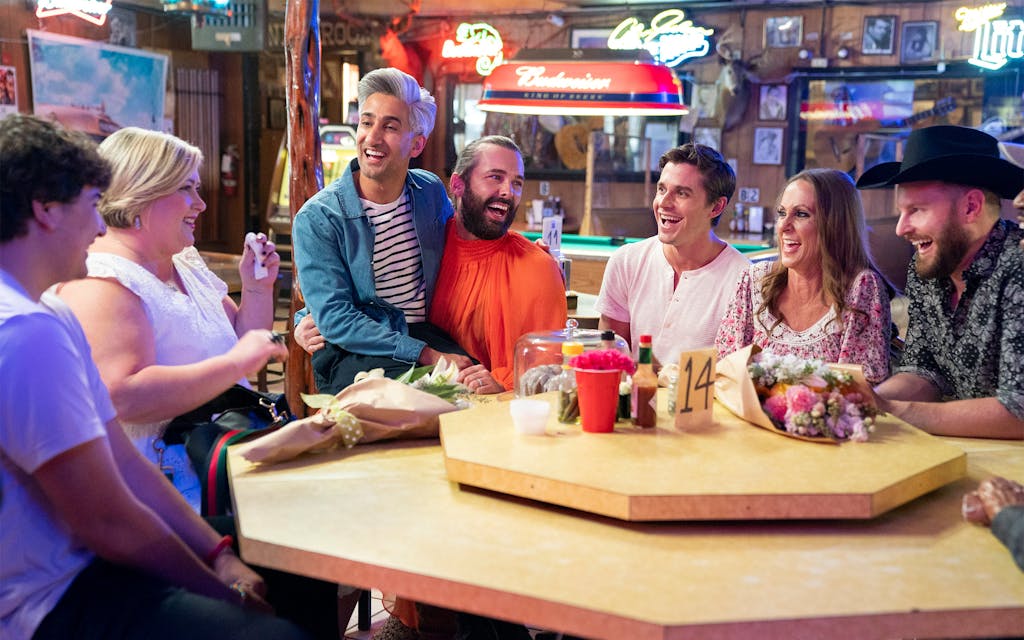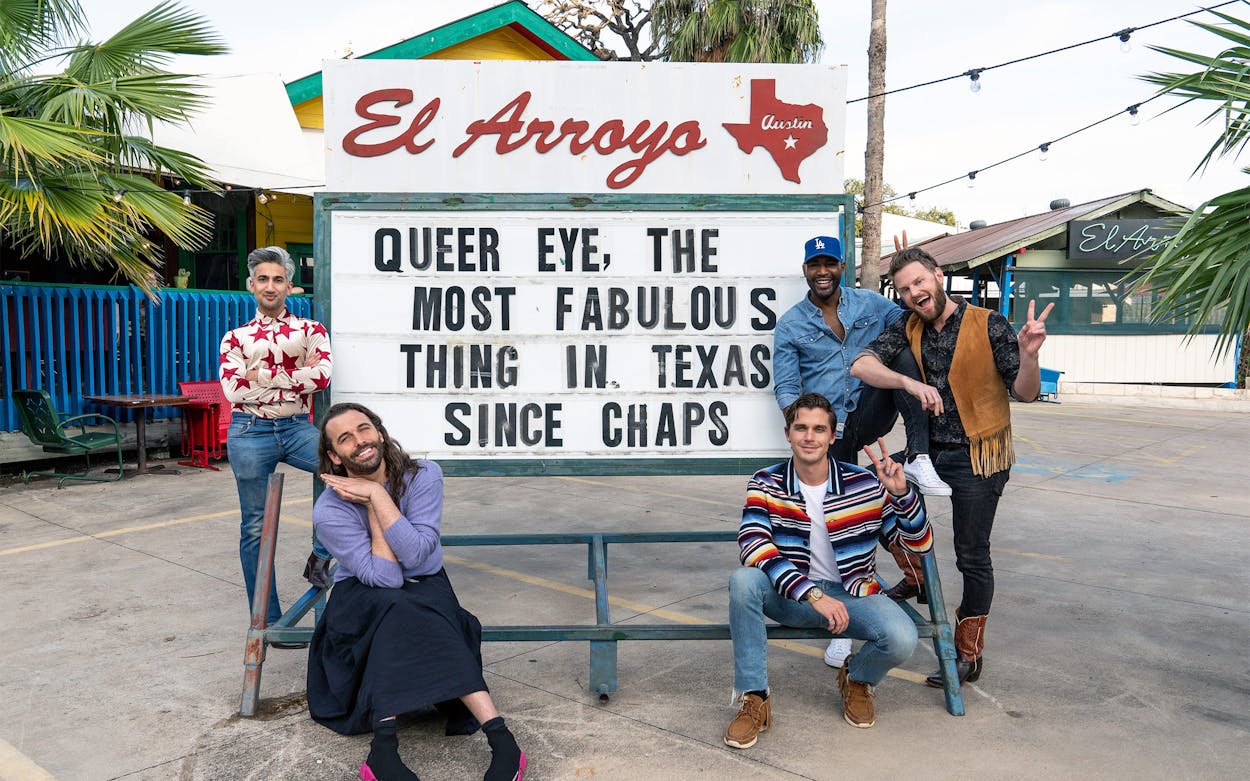Artists have spent much of the past two years struggling to figure out how to address the collective trauma we’ve all experienced during 22 months of fear, loss, cultural division, social distancing, illness, and grief. Many of the things they’ve produced have been valiant attempts to explore all of that while the creators are still very much in the middle of living through it—and while some of them have succeeded at holding a brief mirror to the feelings that we’ve all experienced since COVID-19 changed our lives (my favorites are HBO’s Locked Down, Luke Combs’s “Six Feet Apart,” and this TikTok), there hasn’t been much art that is about how to heal from the massive societal shifts the pandemic has caused.
But there is Queer Eye. Watching the Austin-based sixth season of the Netflix series, I was struck by the way the show’s producers and cast embraced the time and place during which it was made. The “heroes” of Queer Eye—which is what the show calls the subjects of the week-long makeovers the episodes document—mostly received their style, grooming, cooking, home, and interpersonal renovations after March 2020, and the struggles of the pandemic loom large over the season. Throughout the pandemic, I’ve sought art that would offer some sort of perspective on these unusual times, but it’s been scarce, and for good reason—that sort of work takes distance, and it’s impossible to have that right now. Queer Eye, though, is uniquely situated to offer some much-needed perspective.
The premise of Queer Eye from the moment it was rebooted in 2018 has been to use the concrete lifestyle improvements that its “Fab Five” experts offer to help people grow into better, healthier, more capable humans. Over the course of the past several years, that evolved into a formula—the team meets someone who fits into an archetype (the stuck-in-the-past widower; the person who takes care of everyone else to the neglect of their own needs; the kinda-bigoted guy who has the potential to be better; the queer person who’s just coming out; et cetera) and then helps them live like a better-functioning adult. Jonathan teaches them that they can look and feel better if they care for their skin and get a good haircut, Karamo helps them overcome the regrets of their past, Bobby hand-tiles their bathroom, Tan shows them what they look like when they wear clothes that fit properly, and Antoni teaches them a recipe. Those aforementioned character types are all present in the Texas season of the show, but simply seeing the formula play out among folks who’ve endured a year-plus (at the time the show was shot) of living through a global pandemic refreshes the premise of the series.
In season six’s first episode, we meet Terri White, the sixtysomething daughter of the owners of Austin’s legendary Broken Spoke. White is a prickly character, one of the bigger challenges the show has faced—she wears a wig and won’t let Jonathan see her real hair, and is hesitant to engage with Karamo’s attempt to help her reconcile with her daughter (she’s also the subject of a number of troubling Yelp reviews). The episode begins pre-pandemic, and the team finishes its makeover just as the world starts shutting down. The next time our boys see Terri, it’s May 2021, and she appears to have been through a lot; she lost her father to COVID that January, and has come to rely on her family—including her daughter—more than before. She’s also wearing her natural hair, is dressed in the less-ostentatious style Tan showed her, and seems generally less cranky, more calm, and more at peace than she appeared on camera at any point in the pre-pandemic footage. Normally, the Queer Eye subjects get their last follow-up visit at the end of their week of focused attention; in White’s case, it comes after she’s had more than a year to reflect, grieve, and work on herself. At least on television, it appears that she did, inviting the viewer to think about their own journey from March 2020 to whenever they watch the episode.

Those opportunities to reflect come up again and again throughout the season. We meet the kids of Navarro Early College High School’s prom committee, an earnest group of young people who—like teens across the country—lost the social experiences of their junior and senior years of high school after in-person instruction shut down. When the Five arrive, part of their job is helping the students plan a safe, outdoor prom that their classmates will actually want to attend, and that won’t just feel like another diminished pandemic compromise. (Bobby gets them access to the enormous, landscaped lawn of Austin’s Long Center.) It’ll be a while before those students are prepared to really reflect on how this disease robbed them of some of their formative experiences, and for that understanding to shape the things they put out into the world. But for the viewer, spending an hour watching a show that has always been about helping people care for themselves and improve their social skills is a first glimpse at how that process might work.
Dr. Jereka Thomas-Hockaday, cofounder of the Central Texas Allied Health Institute, is one of the show’s “martyr” archetypes—a driven, passionate woman whose sole focus is on providing services to her community. In this case, though, those services are medical training and health care, and especially COVID testing and vaccinations for East Austin residents. We know that health-care providers have been through a lot over the past two years; what we learn through Jereka’s episode is what that toll looks like for an individual who is being given an opportunity on camera to try to recover from it. Musician Reggie DeVore, the subject of the season’s final episode, spent much of the pandemic lamenting the loss of career opportunities he’d been working toward over several years. Watching him reckon with that grief is a reminder that all of us—even those whose losses are less tangible—have lost things that are precious to us, and that we deserve some care (or at least a nice photo shoot).
The fact that Queer Eye episodes tend to follow a pretty conventional recipe makes this season more significant, too, which is an unusual twist for frequent viewers. As endearing as I find its cast (even poor, beleaguered Antoni), I skipped around during the last few seasons, just because the formula started to feel repetitive—but being able to see how the show’s heroes have weathered the pandemic creates a sort of perspective that is only possible because we know how these episodes usually go. We know what the Terri Whites of the Queer Eye–verse tend to be like at the end of their makeovers—full of momentary resolve to utilize their new skills, with a big question mark about whether anything has actually changed for the long term. We’ve seen it a bunch of times before. This season, the narrative plays out differently—change is an ever-present fact of life, especially now—and that difference is present in our own lives, too. It’ll probably be a while before we experience the catharsis, release, and growth from the pandemic that the best art can help us feel when trying to make sense of the major events in our lives—but season six of Queer Eye is a good start.
- More About:
- Film & TV
- Television
- Austin








